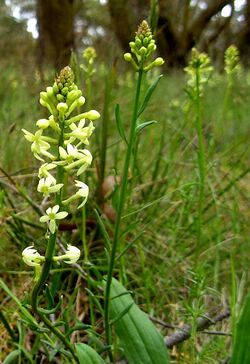Biology:Stackhousia monogyna
| Creamy stackhousia | |
|---|---|

| |
| Scientific classification | |
| Kingdom: | Plantae |
| Clade: | Tracheophytes |
| Clade: | Angiosperms |
| Clade: | Eudicots |
| Clade: | Rosids |
| Order: | Celastrales |
| Family: | Celastraceae |
| Genus: | Stackhousia |
| Species: | S. monogyna
|
| Binomial name | |
| Stackhousia monogyna Labill.[1]
| |
| Synonyms | |
| |

Stackhousia monogyna, commonly known as creamy stackhousia or creamy candles,[2] is a flowering plant in the family Celastraceae. It is a small multi-stemmed plant with narrow leaves and terminal spikes of white, cream or yellow flowers. It is a widespread species found in all states of Australia but not the Northern Territory.
Description
Stackhousia monogyna is a slender, multi-stemmed, perennial herb to 70 cm (28 in) high, covered with soft hairs or smooth on upright or ascending stems. The leaves are dark green, mostly narrow, linear to lance-shaped, up to 30 mm (1.2 in) long, 2–4 mm (0.079–0.157 in) wide and rounded, acute or with a short point at the apex. The inflorescence consists of numerous white, cream or yellow flowers in a densely-packed cylindrical spike, each flower is tubular with five pointed spreading lobes up to 5 mm (0.20 in) long. Flowering occurs from late winter to early summer and the fruit is a wide oval or ellipsoid shaped mericarp, wrinkled to veined and 1.9–2.8 mm (0.075–0.110 in) long.[3][4]
Taxonomy and naming
The species was described in 1861 by Ferdinand von Mueller as Desdemodium acanthocladum.[5][6] In 1805 French naturalist Jacques Labillardière changed the name to Stackhousia monogyna and the description was published in Novae Hollandiae Plantarum Specimen.[7][8] The specific epithet (monogyna) means "one", probably referring to the one-seeded fruit.[9]
Distribution and habitat
Creamy stackhousia is a common widespread species growing in grassland and dry forest on gravel, clay and granite in all states of Australia but not the Northern Territory.[2][4]
References
- ↑ "Stackhousia monogyne". Australian Plant Census. https://biodiversity.org.au/nsl/services/apc-format/display/80288.
- ↑ 2.0 2.1 Brookes, A.K. "Stackhousia monogyna". Royal Botanic Gardens Sydney. https://plantnet.rbgsyd.nsw.gov.au/cgi-bin/NSWfl.pl?page=nswfl&lvl=sp&name=Stackhousia~monogyna.
- ↑ Barker, W.R. "Stackhousia monogyna". Royal Botanic Gardens Victoria. https://vicflora.rbg.vic.gov.au/flora/taxon/39b67dbc-26ba-4e9a-8b61-5a939155dbf3.
- ↑ 4.0 4.1 Sharp, Sarah; Rehwinkel, Rainer; Mallinson, Dave; Eddy, David (2015). Woodland Flora a Field Guide for the Southern Tableland (NSW & ACT). Canberra: Horizons Print Management. ISBN 9780994495808.
- ↑ "Desmodium acanthocladum". Australian Plant Name Index. https://biodiversity.org.au/nsl/services/rest/instance/apni/524077.
- ↑ von Mueller, Ferdinand (1861). Fragmenta Phytographiae Australiae. v.2 1860-61. Melbourne. p. 122. https://www.biodiversitylibrary.org/page/760910#page/127/mode/1up.
- ↑ "Stackhousia monogyna". Australian Plant Name Index. https://biodiversity.org.au/nsl/services/rest/instance/apni/496099.
- ↑ Labillardiere, Jaques (1805). Novae Hollandiae Plantarum Specimen. v.1. p. 77. https://www.biodiversitylibrary.org/item/126969#page/76/mode/1up.
- ↑ George, A.S; Sharr, F.A (2021). Western Australian Plant Names and their meanings (4th ed.). Kardinya: Four Gables. p. 262. ISBN 9780958034197.
Wikidata ☰ Q7595976 entry
 |

